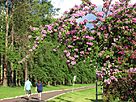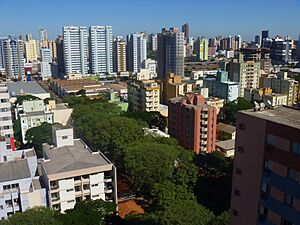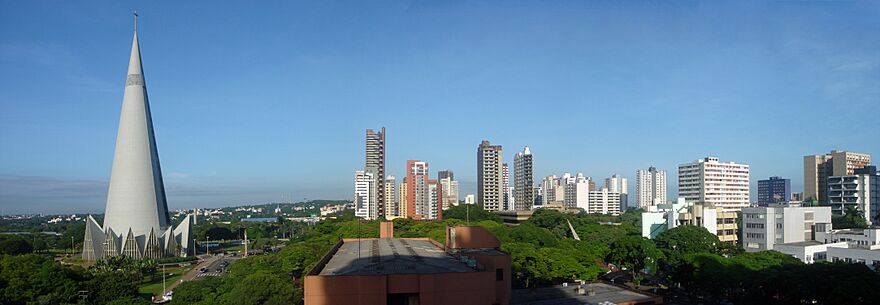Maringá facts for kids
Quick facts for kids
Maringá
|
|||
|---|---|---|---|
|
Municipality
|
|||
| Municipality of Maringá | |||
|
From left to right and top to bottom: skyline of Maringá with the Cathedral of Maringá; the Ingá Park; Grevilea Woods; Park of Japan; Chapel of Santa Cruz de Maringá
|
|||
|
|||
| Nickname(s):
Song City (Cidade Canção), Green City (Cidade Verde)
|
|||

Location in Paraná
|
|||
| Country | |||
| Region | South | ||
| State | |||
| Founded | May 10, 1947 | ||
| Area | |||
| • Municipality | 487.93 km2 (188.39 sq mi) | ||
| • Metro | 5,978.592 km2 (2,308.347 sq mi) | ||
| Elevation | 515 m (1,821 ft) | ||
| Population
(2016)
|
|||
| • Municipality | 403,063 | ||
| • Density | 731.9/km2 (1,896/sq mi) | ||
| • Metro | 783,907 | ||
| Time zone | UTC-3 (UTC-3) | ||
| Postal Code |
87000-000
|
||
| HDI (2010) | 0.808 – very high | ||
Maringá is a city in southern Brazil. It was planned and built starting on May 10, 1947. It is the third-largest city in the state of Paraná. In 2013, about 385,753 people lived in the city itself. The larger metropolitan area had around 764,906 people.
Maringá is located in northwestern Paraná. The Tropic of Capricorn line crosses through it. The city is an important center for shopping, services, and universities, like the State University of Maringá. It also has many farms and food-related businesses.
Contents
Discovering Maringá's Past
How Maringá Got Its Name
Maringá gets its name from a popular song. The song was written by Joubert de Carvalho. He wrote it to honor his great love, Maria do Ingá. Her name was later shortened to Maringá. Because of this, the city is often called "Song City." This song was very famous when the city was first being built.
Building a Planned City
In 1925, a British company called the Northern Paraná Land Company started. This company managed a huge area of land in northern Paraná. Today, some of Paraná's biggest cities are in this area.
The land here was very fertile, meaning it was good for growing crops. This encouraged people from São Paulo to move here. They bought land to grow coffee beans, which were important for selling to other countries. The northern Paraná region is about 100,000 square kilometers. Rivers like Paranapanema, Paraná, Ivaí, and Piquiri flow through it.
A city planner named Jorge Macedo Vieira designed the new city. He worked for the British company. Maringá officially became a municipality (a type of city government) on November 14, 1951.
The company wanted to protect nature. They worried about too many trees being cut down. So, they set aside three large green areas within the city. These were the Forest Horto, the Park of the Ingá, and Forest II. Maringá was planned from the start to be a "garden city." This means it was designed with lots of green spaces.
Who Lives in Maringá?
Different Cultures and People
Maringá has been shaped by many different groups of people. Japanese immigrants have had a big influence. Italian and German immigrants also moved here. People whose families came from Portugal are also a large group. Other groups include people of African and Native American descent, Poles, Spaniards, Ukrainians, Arabs, Jews, and Russians. There is also a small group of British descendants.
Here's a look at the different groups living in Maringá:
| Group | Percentage |
|---|---|
| White | 70.8% |
| Mixed | 19.6% |
| Asian | 3.6% |
| Black | 3.4% |
| Native American | 0.1% |
Famous People from Maringá
- Sônia Braga - An actress
- Celso Portiolli - A TV host
- Fernanda Machado - An actress
- Felipe Drugovich - A racing driver who won the Fia Formula 2 championship
Beliefs and Religions
Most people in Maringá are Roman Catholic. Other major religions include different types of Protestantism. There are also smaller groups of people who follow Islam, Buddhism, Shinto, and Spiritism. Some people do not follow any religion.
- Roman Catholicism: 73.72%
- Protestantism: 21.15%
- Other religions or no religion: 5.13%
Maringá's Natural Surroundings
Understanding Maringá's Climate
Maringá has a tropical rainforest climate. This means it gets a lot of rain throughout the year. The average temperature in the coldest month is about 17.8 °C (64 °F). The average temperature for the whole year is around 21.95 °C (71.51 °F).
Maringá is in southern Brazil and is crossed by the Tropic of Capricorn. This location means its weather is affected by air coming from the Atlantic Ocean and tropical areas. In winter, cold air from the polar regions can sometimes move in. This can cause frosts.
| Climate data for Maringá (1991–2020 normals, extremes 1961–1990) | |||||||||||||
|---|---|---|---|---|---|---|---|---|---|---|---|---|---|
| Month | Jan | Feb | Mar | Apr | May | Jun | Jul | Aug | Sep | Oct | Nov | Dec | Year |
| Record high °C (°F) | 39.1 (102.4) |
37.8 (100.0) |
36.0 (96.8) |
34.0 (93.2) |
32.0 (89.6) |
30.2 (86.4) |
31.4 (88.5) |
34.0 (93.2) |
37.2 (99.0) |
40.7 (105.3) |
39.4 (102.9) |
37.4 (99.3) |
40.7 (105.3) |
| Mean daily maximum °C (°F) | 30.4 (86.7) |
30.5 (86.9) |
30.4 (86.7) |
28.8 (83.8) |
25.1 (77.2) |
24.3 (75.7) |
24.7 (76.5) |
27.1 (80.8) |
28.5 (83.3) |
29.8 (85.6) |
30.3 (86.5) |
30.4 (86.7) |
28.4 (83.1) |
| Daily mean °C (°F) | 25.0 (77.0) |
24.9 (76.8) |
24.6 (76.3) |
23.0 (73.4) |
19.6 (67.3) |
18.7 (65.7) |
18.6 (65.5) |
20.6 (69.1) |
22.2 (72.0) |
23.7 (74.7) |
24.4 (75.9) |
25.0 (77.0) |
22.5 (72.5) |
| Mean daily minimum °C (°F) | 20.9 (69.6) |
20.8 (69.4) |
20.2 (68.4) |
18.6 (65.5) |
15.5 (59.9) |
14.7 (58.5) |
14.2 (57.6) |
15.6 (60.1) |
17.1 (62.8) |
18.8 (65.8) |
19.4 (66.9) |
20.5 (68.9) |
18.0 (64.4) |
| Record low °C (°F) | 10.0 (50.0) |
12.0 (53.6) |
9.0 (48.2) |
3.6 (38.5) |
1.8 (35.2) |
0.1 (32.2) |
0.0 (32.0) |
−0.2 (31.6) |
1.5 (34.7) |
9.0 (48.2) |
9.0 (48.2) |
9.0 (48.2) |
−0.2 (31.6) |
| Average precipitation mm (inches) | 226.0 (8.90) |
200.8 (7.91) |
154.5 (6.08) |
112.9 (4.44) |
118.7 (4.67) |
103.5 (4.07) |
72.9 (2.87) |
66.8 (2.63) |
124.2 (4.89) |
173.0 (6.81) |
154.0 (6.06) |
194.9 (7.67) |
1,702.2 (67.02) |
| Average precipitation days (≥ 1.0 mm) | 14 | 12 | 10 | 7 | 7 | 6 | 5 | 5 | 7 | 10 | 9 | 12 | 104 |
| Average relative humidity (%) | 82.9 | 82.8 | 83.2 | 81.9 | 78.6 | 71.9 | 67.2 | 64.0 | 68.0 | 71.6 | 76.9 | 80.6 | 75.8 |
| Mean monthly sunshine hours | 212.1 | 199.6 | 225.0 | 222.2 | 199.9 | 193.4 | 224.0 | 238.6 | 211.4 | 218.1 | 231.8 | 219.7 | 2,595.8 |
| Source: Instituto Nacional de Meteorologia | |||||||||||||
Maringá's Green Spaces and Flora
Maringá is known for its many green areas. It has a high amount of green space for each person living there. There are 90 acres of native forest spread across 17 protected areas.
The city has large areas of native forest within its limits. These include the Horto Florestal, Parque dos Pioneiros (Bosque II), and Parque do Inga. The Parque do Inga is open to everyone. There are also smaller green spaces like the Parque do Cinquentenário.
Throughout the year, you can see many trees lining the streets. These trees help keep the air clean. Especially from winter to spring, many trees burst into colorful flowers. Maringá has one of the highest amounts of green space per person, with 26.65 square meters per inhabitant.
Keeping Maringá Green: Pollution Challenges
Even with the usual challenges of a city, Maringá tries to keep its reputation as a "green city." It was planned from the start with forest reserves, wide roads, and many types of trees.
Maringá has a lot of vehicles for its size. Because of this, some parts of the city have higher pollution levels than recommended. Two areas, Duque de Caxias and Colombo avenues, face the biggest issues. Factories, farm chemicals, noise, and household trash also add to the city's pollution. Despite these challenges, Maringá still works hard to be known as a green city.
Maringá's Economy
Maringá is well-known for its businesses and services. The service sector is the biggest part of Maringá's economy (76.74%). This includes things like shops, restaurants, and offices. Next is the industrial sector (22.29%), which makes products. Farming makes up a smaller part (0.97%). In the industrial sector, food processing, chemicals, and textiles are the most important.
Farming in Maringá
Farming is still very important for Maringá, even though its role has become smaller over the years. Farmers grow many different crops. Besides coffee, they now produce corn, wheat, cotton, beans, peanuts, rice, sugar cane, and especially soybeans.
Maringá's Industries
Maringá's industries include metalworking, agribusiness (businesses related to farming), textiles, and food companies. The industrial sector is growing. The city has many companies that make clothes and process farm products. Big companies like Cocamar and Coca-Cola create many jobs in the area. Metalworking industries sell products all over Brazil and to other countries in Latin America. Maringá is also a fashion center in southern Brazil. It has the largest wholesale mall in Latin America, called Mercosul. Recently, Maringá has also become important in the software industry.
Services and Shopping
Maringá has five shopping malls: Avenida Center Mall, Cidade Mall, Mandacaru Boulevard Mall, Maringá Park Mall, and Catuaí Maringá Mall. The Catuaí Maringá Mall is the second largest in Paraná state.
Maringá is a great place for shopping. It has many different types of stores. You can find food products, medicines, clothes, electronics, books, and many restaurants. Since it's a wholesale center, prices are often good. This attracts shoppers from other parts of Paraná, São Paulo, and even some cities in Mato Grosso and Mato Grosso do Sul.
Businesses here sell many things in bulk. These include food, paper, glass, textiles, wood, car parts, and appliances. Many clothing factories also sell their products wholesale.
The city has the Maringa and Region Convention & Visitors Bureau. This group works to help the local economy by encouraging tourism and events. It helps plan and develop tourism, bringing Maringá into national and international travel plans.
The Sílvio Name Júnior Regional Airport has flights to major cities in Brazil.
Sports in Maringá
Maringá has two professional football (soccer) clubs. They are Grêmio Maringá and Maringá FC. Grêmio Maringá plays in the second division of the state championship. Maringá FC plays in the first division. Both teams play their games at the Stadium Willie Davids. This stadium can hold up to 15,300 fans. Grêmio Maringá is the older club and has won three state championships. Maringá FC has not won any titles yet.
Learning in Maringá: Universities
Maringá has several universities and colleges. Here are some of the most well-known, based on how many students they have:
- UEM - This is a public university supported by the state of Paraná.
- UEM, the only public university of Maringa (in Portuguese)
- CESUMAR - Centro de Estudos Superiores de Maringá, also known as Centro Universitario de Maringá.
- Cesumar, one of the private colleges in Maringá (in Portuguese)
- PUC - Pontificia Universidade Catolica do Paraná - Campus Maringá
Media and Communication
Maringá has good access to internet, radio, newspapers, television, and phone services. The city has 15 TV stations and substations. It also has 14 FM radio stations.
Sister Cities
Maringá has special friendships with other cities around the world. These are called "sister cities":
 Caserta, Italy (since 2000)
Caserta, Italy (since 2000) General San Martín, Argentina (since 1993)
General San Martín, Argentina (since 1993) Kakogawa, Japan (since 1972)
Kakogawa, Japan (since 1972) Leiria, Portugal (since 1982)
Leiria, Portugal (since 1982)
Notable People from Maringá
Here are some well-known people who were born in Maringá:
- Celso Portiolli, a television presenter
- Everaldo Matsuura, a chess Grandmaster
- Felipe Drugovich, a racing driver
- Gilsinho, a footballer
- Leonardo Drugovich, a former professional footballer
- Sergio Moro, a former judge and politician
- Sônia Braga, an actress
See also
 In Spanish: Maringá para niños
In Spanish: Maringá para niños




















